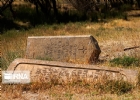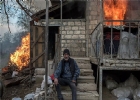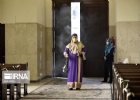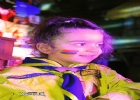
Gündem :
25 Ağustos 2022
![]()
![]()
![]()
Lido is one of most fascinating parts of Venice. And the fact that a house on one of its main streets has a nameplate bearing the name “Mavian” is exciting for me. It is always a pleasure to meet the hostess, Marina Mavian, who lives between Milan and Lido, and to hear her life stories as a ballerina and an artist, as a descendant of Armenian refugees and as the president of Casa Armena — Hay Dun (Armenian cultural center) in Milano.
It is August, I am again in Venice and enjoy another nice conversation with Marina Mavian at her beautiful house.
Marina, what did ballet give you and what does painting gives you today?
Ballet was the first part of my life. In ballet there are lots of rules. One should be very serious about doing classical ballet, and it certainly leaves a mark on you, whatever other career you might pursue.
I went to Armenia for the first time in 1998, and it was shock for me to see the state our ancient churches were in. I wanted to raise awareness on our treasures — khachkars, churches and miniatures, in Italy. Painting had been a hobby for me since I was a dancer; I used to paint in my free time, but after my trip to Armenia I started painting religious subjects. I consider it my mission. I was surprised that during my exhibitions people asked: “So, are Armenians Christians?!” Art is an effective way to transmit our rich spiritual culture to people who might have not yet been able to see original miniatures at the manuscript collections of San Lazzaro or at the Matenadaran in Yerevan. I provide another way to access Armenian art. Of course, what I make is not identical copies, but my work is inspired and embedded in the same tradition.
Some of my work is permanently exhibited in quite meaningful places. For example, three of my paintings are displayed in Turkey. They were commissioned by the late Monsignor Luigi Padovese, the apostolic vicar of Anatolia in Turkey, who was brutally murdered 12 years ago. So if you go to Turkey, you will see a big Saint George and the dragon at the Iskenderun Catholic church and a Saint Paul and an icon at the Catholic convent in Tarsus.
Get the Mirror in your inbox:
Enter your email address
How many years have you been in charge of the Armenian house (Casa Armena –Hay Dun) in Milano?
I started being involved in 2002, with Mrs. Armine Sirabian, who has been the president of Hay Dun before me for 25 years, a wonderful woman and a very active member of our community. I became president in 2008. We do not have sponsors, and it is difficult to keep our finances afloat, but we hope to be able to continue our activity. The Casa Armena – Hay Dun was founded in 1953, when most people knew little, or nothing, about Armenians in Milan. One of its main goals was also to make Armenian culture known to Italians. Our venue is big, which allows us to have various kinds of activities. We organize conferences, book launches, concerts, film screenings, exhibitions of Armenian artists, and so on. We also celebrate festivities there — Christmas, Michink, Vartanants, the Republic anniversaries of May 28 and 21st of September. When I was younger, they even organized amateur theatre representations in Armenian, but it has not been done in a while.
When I first came to Venice in 1998, among the stores of San Marco square there was one bearing the name Mavian.
Yes, my father owned two cameras shops in Venice, although his main work was in Milan. One can still read “Foto Record 90” on the sign in San Marco square, although the store is no longer ours.
How was it to grow up as an Armenian in Venice?
I would say that for us it was normal to be Armenian here on Lido. The community was bigger back then. My father, a former student of Moorat-Raphael, was very happy to live in Venice. Armenians were known here since the time of the Venetian Republic as there were many merchants, not to mention San Lazzaro degli Armeni, the island of the Mekhitarist fathers, as well as the Moorat-Raphael Armenian college. My parents talked to us in Armenian rarely, but they spoke it to communicate with each other, so we learned some as children. Our best teacher was my paternal grandmother Anna (Gulmesian Mavian), who lived in our house, and spoke Armenian to us, but unfortunately she passed away when I was two years old. It is very difficult to get an education in Armenian in Italy – Moorat-Raphael was for boys only at that time. In any case, I always say I am Italian, and also Armenian.
Topics: Casa Armena
People: Marina Mavian
MORE FROM ARMENIAN GENOCIDE
BOOKSTRANSLATIONS
Trashland: An Armenian Dystopia
Where was your family from?
My father Girair (Jirayr) was from Bursa, and his family moved to Constantinople, when he was a child. I have been to Istanbul three times and it was a strange feeling to know my family house is still somewhere in that city. My mother was born in Venice to an Italian father, Carlo Mascarin and an Armenian mother, Nevart Ichlemedjian, who was from Smyrna, now Izmir. When they got engaged, they planned to live in Smyrna together. But while Nevart and Carlo were in Venice, the big fire of Smyrna happened in September 1922, so they never returned to Turkey. Meanwhile, Nevart’s parents managed to escape from there and moved to their daughter’s place in Venice.
Do you have family relics?
We do. (Marina takes me to another room and shows me a painting on the wall). This Madonna and child, painted in 1870 by an Armenian painter, is from Smyrna. My grandmother’s mother, Makruhi, while escaping from the fire with her husband Karnik, instead of taking jewels or money, took this painting. A Turkish gendarme attacked her with a sword, but she shielded herself with this painting, and you can see a cut on it. Then they jumped into the water and swam to a French vessel. You can see also traces of the water here. They reached Italy on that French ship and were refugees in a camp in Puglia. From there, they found their way to Venice. Their daughter Nevart had no news from her parents for a long time. One day she saw her mother and father, both safe and sound on her doorstep in Venice, with the portrait of the Madonna…
Another survivor of my family was uncle Boghos (Shishmanian), Nevart granny’s cousin. He was around 18 years old at the time of the Genocide, when they took him away, and just like in Fatih Akin’s film, “The Cut,” they cut his throat. Boghos was left under a heap of dead bodies, but his bleeding was stopped by the snow, and he managed to survive. He, too, eventually reached Venice, where he found employment and continued his life.
It is great that you also formed an Italian-Armenian family. Moreover, your daughter is involved in Armenian studies.
Yes, I am very proud of this. My daughter Stephanie (Pambakian) devoted many years to her studies and defended her doctoral dissertation on seventh century Armenian scientist Anania Shirakatsi last March under the supervision of Prof. Valentina Calzolari (University in Geneva), Dr. Tim Greenwood and Prof. Palmer (University of St Andrews). She also taught courses of Classical Armenian in Casa Armena – Hay Dun. Some Armenians from the community took part, but there was also a great participation from an Italian audience – among the students, we were honored to have Don Matteo Crimella, a catholic priest and lecturer at the Facoltà Teologica of Northern Italy. He produced a beautiful translation and commentary of the 24-stanzas prayer of Nerses Shnorhali, “In Faith I Confess,” which also features the grabar original. Stephanie presented this book in Hay Dun last June, and Don Crimella said that thanks to Stephanie he finally had access to the wealth of Armenian spiritual literature. This makes me more proud of my daughter!
It is August, I am again in Venice and enjoy another nice conversation with Marina Mavian at her beautiful house.
Marina, what did ballet give you and what does painting gives you today?
Ballet was the first part of my life. In ballet there are lots of rules. One should be very serious about doing classical ballet, and it certainly leaves a mark on you, whatever other career you might pursue.
I went to Armenia for the first time in 1998, and it was shock for me to see the state our ancient churches were in. I wanted to raise awareness on our treasures — khachkars, churches and miniatures, in Italy. Painting had been a hobby for me since I was a dancer; I used to paint in my free time, but after my trip to Armenia I started painting religious subjects. I consider it my mission. I was surprised that during my exhibitions people asked: “So, are Armenians Christians?!” Art is an effective way to transmit our rich spiritual culture to people who might have not yet been able to see original miniatures at the manuscript collections of San Lazzaro or at the Matenadaran in Yerevan. I provide another way to access Armenian art. Of course, what I make is not identical copies, but my work is inspired and embedded in the same tradition.
Some of my work is permanently exhibited in quite meaningful places. For example, three of my paintings are displayed in Turkey. They were commissioned by the late Monsignor Luigi Padovese, the apostolic vicar of Anatolia in Turkey, who was brutally murdered 12 years ago. So if you go to Turkey, you will see a big Saint George and the dragon at the Iskenderun Catholic church and a Saint Paul and an icon at the Catholic convent in Tarsus.
Get the Mirror in your inbox:
Enter your email address
How many years have you been in charge of the Armenian house (Casa Armena –Hay Dun) in Milano?
I started being involved in 2002, with Mrs. Armine Sirabian, who has been the president of Hay Dun before me for 25 years, a wonderful woman and a very active member of our community. I became president in 2008. We do not have sponsors, and it is difficult to keep our finances afloat, but we hope to be able to continue our activity. The Casa Armena – Hay Dun was founded in 1953, when most people knew little, or nothing, about Armenians in Milan. One of its main goals was also to make Armenian culture known to Italians. Our venue is big, which allows us to have various kinds of activities. We organize conferences, book launches, concerts, film screenings, exhibitions of Armenian artists, and so on. We also celebrate festivities there — Christmas, Michink, Vartanants, the Republic anniversaries of May 28 and 21st of September. When I was younger, they even organized amateur theatre representations in Armenian, but it has not been done in a while.
When I first came to Venice in 1998, among the stores of San Marco square there was one bearing the name Mavian.
Yes, my father owned two cameras shops in Venice, although his main work was in Milan. One can still read “Foto Record 90” on the sign in San Marco square, although the store is no longer ours.
How was it to grow up as an Armenian in Venice?
I would say that for us it was normal to be Armenian here on Lido. The community was bigger back then. My father, a former student of Moorat-Raphael, was very happy to live in Venice. Armenians were known here since the time of the Venetian Republic as there were many merchants, not to mention San Lazzaro degli Armeni, the island of the Mekhitarist fathers, as well as the Moorat-Raphael Armenian college. My parents talked to us in Armenian rarely, but they spoke it to communicate with each other, so we learned some as children. Our best teacher was my paternal grandmother Anna (Gulmesian Mavian), who lived in our house, and spoke Armenian to us, but unfortunately she passed away when I was two years old. It is very difficult to get an education in Armenian in Italy – Moorat-Raphael was for boys only at that time. In any case, I always say I am Italian, and also Armenian.
Topics: Casa Armena
People: Marina Mavian
MORE FROM ARMENIAN GENOCIDE
BOOKSTRANSLATIONS
Trashland: An Armenian Dystopia
Where was your family from?
My father Girair (Jirayr) was from Bursa, and his family moved to Constantinople, when he was a child. I have been to Istanbul three times and it was a strange feeling to know my family house is still somewhere in that city. My mother was born in Venice to an Italian father, Carlo Mascarin and an Armenian mother, Nevart Ichlemedjian, who was from Smyrna, now Izmir. When they got engaged, they planned to live in Smyrna together. But while Nevart and Carlo were in Venice, the big fire of Smyrna happened in September 1922, so they never returned to Turkey. Meanwhile, Nevart’s parents managed to escape from there and moved to their daughter’s place in Venice.
Do you have family relics?
We do. (Marina takes me to another room and shows me a painting on the wall). This Madonna and child, painted in 1870 by an Armenian painter, is from Smyrna. My grandmother’s mother, Makruhi, while escaping from the fire with her husband Karnik, instead of taking jewels or money, took this painting. A Turkish gendarme attacked her with a sword, but she shielded herself with this painting, and you can see a cut on it. Then they jumped into the water and swam to a French vessel. You can see also traces of the water here. They reached Italy on that French ship and were refugees in a camp in Puglia. From there, they found their way to Venice. Their daughter Nevart had no news from her parents for a long time. One day she saw her mother and father, both safe and sound on her doorstep in Venice, with the portrait of the Madonna…
Another survivor of my family was uncle Boghos (Shishmanian), Nevart granny’s cousin. He was around 18 years old at the time of the Genocide, when they took him away, and just like in Fatih Akin’s film, “The Cut,” they cut his throat. Boghos was left under a heap of dead bodies, but his bleeding was stopped by the snow, and he managed to survive. He, too, eventually reached Venice, where he found employment and continued his life.
It is great that you also formed an Italian-Armenian family. Moreover, your daughter is involved in Armenian studies.
Yes, I am very proud of this. My daughter Stephanie (Pambakian) devoted many years to her studies and defended her doctoral dissertation on seventh century Armenian scientist Anania Shirakatsi last March under the supervision of Prof. Valentina Calzolari (University in Geneva), Dr. Tim Greenwood and Prof. Palmer (University of St Andrews). She also taught courses of Classical Armenian in Casa Armena – Hay Dun. Some Armenians from the community took part, but there was also a great participation from an Italian audience – among the students, we were honored to have Don Matteo Crimella, a catholic priest and lecturer at the Facoltà Teologica of Northern Italy. He produced a beautiful translation and commentary of the 24-stanzas prayer of Nerses Shnorhali, “In Faith I Confess,” which also features the grabar original. Stephanie presented this book in Hay Dun last June, and Don Crimella said that thanks to Stephanie he finally had access to the wealth of Armenian spiritual literature. This makes me more proud of my daughter!
Bu haber kaynağından gelmektedir.
Haber metninde yer alan görüşler haber kaynağı () ve yazarına ait olup,
bolsohays.com sitesi haber hakkında herhangi bir görüş üstlenmemektedir.
Opinions expressed are those of the author(s)-(). They do not purport to reflect the opinions or views of bolsohays.com
Diğer Haberler
-
THY, İstanbul–Erivan Seferlerine Başlıyor
-
Ermenistan ve Azerbaycan sınır birlikleri bir anlaşma yaptı
-
Şanlıurfa’daki Ermeni kilisesi camii oldu
-
Kostanyan: TRIPP’in yanı sıra Azerbaycan’la başka demiryolu seçenekleri de değerlendiriliyor
-
Azerbaycan’da faaliyet gösteren Türk şirketi: “Bizimle Ermenilerden daha kötü davrandılar
-
Azerbaycan Zengezurda ısrarlı, Ermenistan Kabul edilemez diyor
-
Ermenistan`a gelen turist sayısında rekor
-
Ermenistan’ın kış sanat rehberi
-
Arman Etyemez kimdir, mesleği ne?
-
Paşinyan’ın uçağı Moskova’ya iniş yapamadı
-
Üsküdar Surp Garabet Vakfı’ndan mülk satışı
-
Paşinyan’dan Azerbaycan’a ortak bir yol haritası teklifi
Foto Galeri Tüm Galeriler
Video Galeri Tüm Videolar
-
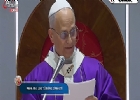
Papa XIV. Leo`nun Türkiye Ziyareti | Volkswagen Arena Efkaristiya Ayini
-
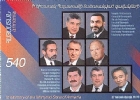
Parliament Shooting in Armenia, October 27, 1999
-

Albert - Brave Heart | ???????? Armenia | Official Music Video | Junior Eurovision 2025
-
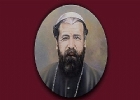
Սրբադասման Սուրբ Պատարագ եւ Հրեշտակ Տեառն Մարեմեան աղօթք 19 հոկտեմբեր 2025 – Լեւոն ԺԴ. Քահանայապետ
Anket Tüm Anketler
Günün Sözü
Հաւատքն է այն իոր համոզում թէ Աստուած ուղղակի կերպով կը միջամտէ մարդկային գործերուն։











